Pros
Cons
Testing / Performance
So you’re on a trip with some family or friends, and you come across a beautiful landscape. You pull out your camera and snap a photo, capturing the stunning view. However, depending on the camera you’re using, the colors of the landscape and your friend’s faces will turn out very differently. Some cameras may boost the blues in skies, making them brilliant but unnatural, and others may shift reds and yellows making faces look either more enlivened, or extremely flushed.
We test color accuracy by photographing an industry standard GretagMacbeth ColorChecker test chart, and then compare the colors the camera reproduces with the known colors of the ColorChecker. The ColorChecker chart consists of 24 tiles of different colors from around the spectrum. Some of the tiles in the top row are designed to correspond with sky blues, foliage greens, and flesh tones, while the rest of come from all over the color spectrum.
The image below represents the V803’s performance. The outer squares represent the camera’s colors, the inside squares show the actual color of the ColorChecker corrected for the exposure, and the small rectangle shows the actual color of the ColorChecker in an even exposure. Because the V803 lacks manual white balance, the charts show the camera’s tungsten preset white balance performance.
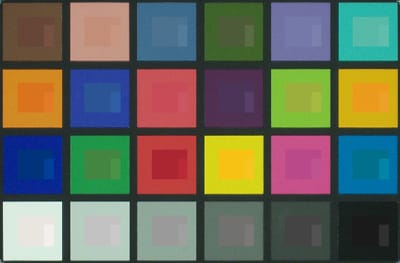
Take a look at the outer squares compared to the inner squares. A few of them are very similar, but many of them stray from the actual colors of the ColorChecker test chart, especially the yellows. The graph below shows this information in a more quantitative way. The actual colors of the test chart are shown as squares on the color spectrum, while the colors the camera reproduced are shown as circles. The line connecting the squares and circles shows the amount of color error.
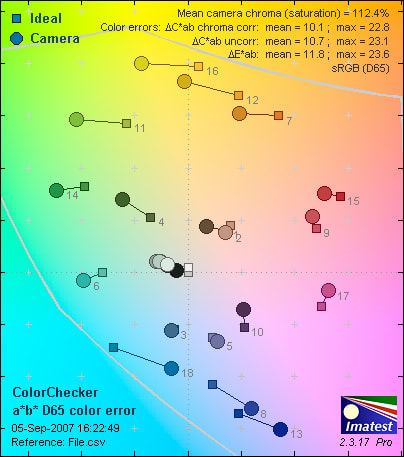
The V803 has a mean color error of 10.7 in L**a**b* color space, which is almost twice as much error as some other cameras we have tested this year. Notice on the graph how many of the colors are shifted, especially yellows and blues. This color error will definitely affect colors in landscapes and portraits, making faces greener and skies a different shade blue. Many of the colors are also oversaturated. This can look good in some photos, but can also be a distraction. The reds and purples, however, are quite accurate. Overall, the V803 has poor color accuracy, falling well below the 2007 Point-and-Shoot average and similarly priced cameras like the Casio EX-Z75.
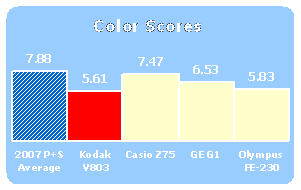
**Resolution ***(7.31) *
We test a camera’s resolution by photographing an industry standard resolution test chart at varied focal lengths and exposure settings. We run the images through Imatest to find the settings that produce the sharpest image. Imatest measures resolution in terms of line widths per picture height (lw/ph), which correspond to the number of equally spaced alternating black and white lines that can fit in the picture frame before becoming blurred.
[
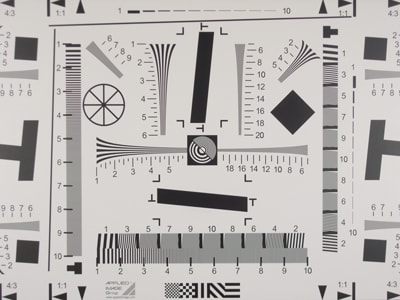
](https://www.reviewed.com/cameras/viewer.php?picture=V803-Res-lg.jpg)
Click to view the high-resolution image
The V803 was sharpest at ISO 80, f/4.0, and a focal length of 17mm. It resolved 1766 lw/ph horizontally with 3 percent oversharpening, and 1018 lw/ph vertically with 29.4 percent undersharpening. The camera probably could’ve used some more vertical sharpening, but the images look nice and sharp regardless, and lack any serious image artifacting. The only problem with the V803’s resolution is that the corners of the images are blurred and out of focus. This will definitely be apparent if you try to crop your images, or print them large. In other words, the centers of your photos will be very crisp, but the corners may be blurry.
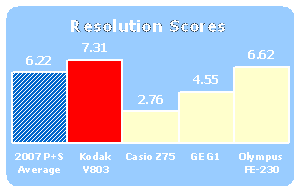
Noise – Manual*(3.93)*
In a similar way that TVs have static and stereos have a background hiss, digital cameras have image noise. This "noise" often looks quite ugly, showing up in images as randomly scattered bright dots or splotches which can sometimes even be colored. Noise is created inside a camera, and increases as ISO sensitivity is increased. Many new digital cameras this year are applying in-camera noise reduction, which makes image noise less pronounced, but instead blurs over details.
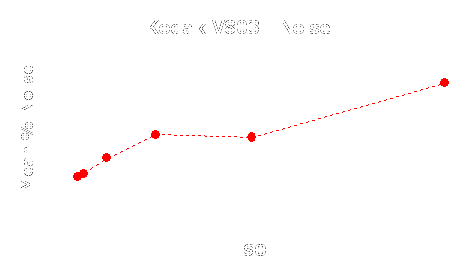
We examine noise levels by photographing our test chart under bright studio lights at every ISO sensitivity. The V803’s noise stays quite low at ISO 80 and 100, but then increased steadily at higher ISOs. Interestingly, noise levels decrease slightly from ISO 400 to 800, hinting at in-camera noise reduction. Closer examination of the images proves this is the case (click on the still life images below to see full resolution versions). At ISO 800 the images are "smoothed", reducing noise but also blurring over detail. At ISO 1600 noise levels are extremely high and blurred. Overall, the V803 scored poorly in noise, though this is often the case with budget cameras. Avoid using it at high ISO sensitivities whenever possible.
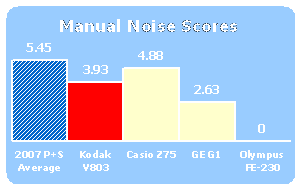
Noise – Auto*(1.06)*
We photograph the test chart in the lab under the same bright studio lights with the camera set to Auto ISO. With the camera set to ISO 160, 1.9 percent of the image is lost to noise. This is a lot more noise than we would like to see in such bright lighting, and hints at how much noise you will see in your images in less-than-ideal conditions.
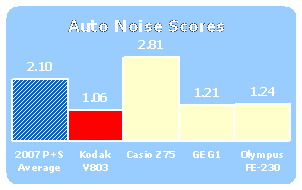
White Balance Performance *(3.03)
*Every kind of light source has a slightly different color temperature, such as fluorescent, tungsten, and daylight. In order to accurately depict colors, a camera must adjust for the different color cast of each kind of light. This is called white balance, and most digital cameras have a manual white balance setting, an auto setting, and presets for different kinds of light. Poor white balance can give a strong color cast to an image, often either yellow or blue.
The Kodak V803 has no manual white balance setting and entirely relies on the auto setting and presets. We photograph the ColorChecker test chart under flash, fluorescent, outdoor shade, and tungsten lighting to see how accurately it reproduces whites and grays.
Auto (3.37)
The white balance using the Auto setting on the V803 is dismal. Flash and outdoor shade lighting produces images with a strong blue cast, while under tungsten the images are extremely yellow. Photos under fluorescent light fair just as badly, and look yellowish-red.
Preset (2.68)
We would suggest using the presets instead of the miserable auto setting, but unfortunately the presets are even less accurate. We have never seen a camera that gives such a strong blue cast to a neutral test chart as the V803’s fluorescent setting. The tungsten preset gives images an odd aqua-colored cast that will only be helpful in shots where you’re going for an "underwater" look, which will probably be never. The Kodak V803 has the worst white balance of any camera we have seen this year.
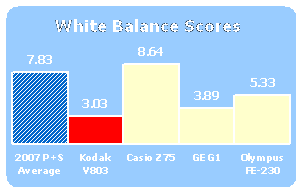
**Still Life Sequences
***Click to view the high-resolution image*
**
Low Light***(4.92)*
We dim our studio lights to test a camera’s color accuracy and noise levels in less-than-ideal light conditions. We lower the light levels to 60, 30, 15, and 5 lux to test the limits of the camera’s sensor. 60 lux corresponds to a room softly lit by two lamps, 30 lux is approximately a room lit by a single 40 watt bulb, 15 lux is the light from a TV, and 5 lux is about as dark as a room lit by a small nightlight. All shots are taken at ISO 1600.
The EasyShare V803’s color accuracy is poor in low light, but actually improves as the lights are lowered. The V803 doesn’t quite properly expose at 5 lux, showing the camera has clear limits in low light. Noise levels are very high at all low light levels, again showing how poor the ISO 1600 setting is on the V803. Lower ISO settings produce less noise, but won’t let you shoot in as dimly-lit situations. Overall, the camera is poor in low light, yet performs better than similar budget point-and-shoots, the Casio EX-Z75, and the Olympus FE-230, but worse than the GE G1.
We also test long exposure performance of cameras in low light, but only at ISO 400 so that we can standardize the test. The V803 has a Long Time Exposure menu that allows adjustment of up to 8 second long exposures, but won’t shoot at ISO 400. In a 0.5 second exposure at this ISO, the camera has a mean color accuracy of 12.4 and percent noise level of 2.56, neither of which are good scores.
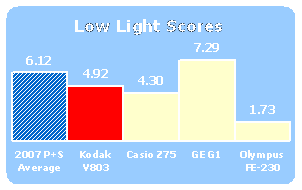
Dynamic Range*(4.52)*
Dynamic range is an image quality factor that describes how well a camera can discern detail in both bright and dark areas of an image. For example, if you are taking photos at a wedding, a camera with good dynamic range would be able to show lots of detail in a bride’s white dress, as well as detail in a groom’s black tux, in the same photo. A camera with poor dynamic range might just blow out the white dress and render the tux as a shapely black mass.
We test dynamic range by photographing a backlit Stouffer step chart in our lab. The Stouffer chart consists of a row of rectangles, each a slightly different shade of gray ranging from brightest white to darkest black. The more rectangles the camera can discern, the better its dynamic range.
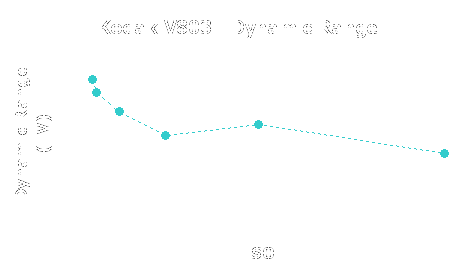
The V803 has mediocre dynamic range at ISO 80 and 100, and then drops to very low levels at higher ISO settings, as you can see in the graph above. Above ISO 200, you risk blowing out highlights and losing detail in dark areas. The V803 had one of the lower dynamic range scores for the point-and-shoots this year, though you’ll be hard pressed to find a budget camera with very good dynamic range.
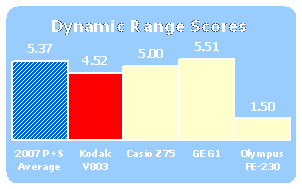
Speed/Timing **– All speed tests were conducted using a Kingston Ultimate 120X 2GB SD Card
*Startup to First Shot****(3.2) *
The V803 is exceptionally hard to turn on, requiring the On button to be held for a few moments. Once it is on it takes approximately 6.8 seconds to take a photo, which is an amazingly long time for a digital camera in today’s market. Holding the shutter button from when the camera is turned on will not fire a shot. Instead, if you need to take a quick picture, you must continuously click the shutter and wait for the autofocus to adjust.
Shot-to-Shot (9.5)
In Burst mode, the V803 takes four shots in 1.9 seconds, which is approximately 0.55 seconds between shots. This speed will help for capture some good action shots.
Shutter-to-Shot (8.6)
The camera takes 0.2 seconds to fire a shot after it has been prefocused by holding the shutter down halfway. Without being prefocused, the camera takes 2.2 seconds to fire a shot.
Processing (4.0)
The V803 took 3.0 seconds to process a 2 MB photo taken at ISO 160. However, the camera can continue to shoot while it is processing.
**Video Performance ***(1.67) *
Bright Indoor Light – 3000 lux
To test video in bright light, we record footage of our color charts at 3000 lux in tungsten light. The V803’s color error is quite high, at 17.3, and saturation is 137 percent. These numbers sound bad, but are actually normal for a camera recording video in tungsten light with auto white balance. That is to say, cameras don’t shoot great video, and this Kodak is no exception.
*Low Light – 30 lux *
At 30 lux the V803 can barely expose well enough to make out the chart. See the image of the video color test chart below, and note how incredibly dark it is. The numbers are hardly even relevant here; the V803 cannot shoot record video at 30 lux. Good luck trying to get a video of your friends in a low-lit bar or bowling alley, let alone anywhere outside at nighttime.
*Resolution *
We also recorded video of our resolution test chart to see how crisp a camera’s video mode is. Note that video is shot in 640 x 480 resolution, not the 8-megapixels that the still images are. The V803 has trouble focusing in Movie mode. It records 160 lw/ph horizontally with 26.9 percent undersharpening, and 167 lw/ph vertically with 26.7 percent undersharpening. These numbers are extremely low even for video resolution.
Motion
We took the V803 down to the street to capture some action. When recording motion, the video had really bad moiré, soft focus, poor detail in dark areas, image artifacting from over-compression, flashing from inexplicable exposure shifts, and some stuttering. On the good side, the colors looked nice. Overall, the video of the V803 looks terrible, so don’t buy this camera expecting to get much of anything out of the video mode.
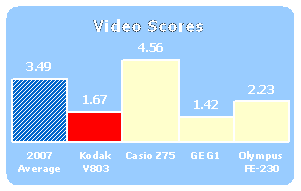
Components
Viewfinder* (0.0)*
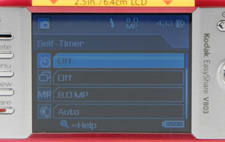
The Kodak V806 lacks an optical viewfinder, a trend on point-and-shoots. The LCD’s live preview function is instead used as a viewfinder.
LCD*(6.0)
*The 2.5-inch LCD is the same size as its predecessor, the V603. The monitor size is average for current point-and-shoots, but more expensive models have 3- or 3.5-inch screens. The pixel resolution is below average for the current market. Kodak downgraded the V803’s screen resolution to 154,000 pixels from theV603’s 230,000 pixels. While the screen size will provide ample view for passing the camera around to share photos, the low resolution will make users squint to make out fine details.
Flash*(4.75)
*

The EasyShare V803 has a moderately-sized, built-in flash located to the left of the lens. Users can access the flash settings through a dedicated button while in Auto mode. The options are: Auto Flash, Fill, Red-Eye Reduction,, and Off. Some Scene modes, including Landscape, override the flash setting.
The flash is extremely ineffective. With an illumination range of 2 to 9.8 feet at 400 ISO in wide shooting and 2 to– 6.6 feet at 200 ISO in telephoto shooting, the camera’s weak flash results in dark photos, even with subjects within the range. The flash produces better results when subjects are close to the camera. The flash is a weak component of the V803; users are better off using available light.
Zoom Lens*(5.25)*
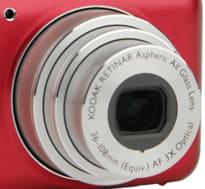
The Kodak EasyShare V803 has a 3x optical zoom Kodak Retinar lens (35mm equivalent of 36-108mm) with an aperture of f/2.8 to f/4.9. The focal length is standard for point-and-shoots and the wide end of the aperture range is slightly better than several of its competitors.
Users can utilize the zoom function with the wide/telephoto toggle button on the camera’s back. The lens chugs along, making loud, distracting sounds when users zoom in and out. The wide end of the zoom range allows users to capture group shots without cutting people out of the photo, while the telephoto capabilities allow for close-up shots. For extra zoom, the camera has 4x digital zoom. The V803 lacks optical image stabilization, as almost all $200 point-and-shoots do.
The optical zoom can be engaged during Movie mode, which isn’t common in point-and-shoots, which usually only enable digital zoom. The zoom is so loud, however, that the mechanical noise is audible in movie clips.
Overall, the V803’s lens’ specs are slightly better than some competing models such as the Canon PowerShot SD40 and General Electric G1. However, longer, optically stabilized lenses can be had for slightly more money. For instance, Canon’s PowerShot A570 IS, which can be found for a little more than $200, has a 4x zoom lens with image stabilization.
Design / Layout
Model Design / Appearance*(8.25)
*The Kodak EasyShare V803 is petite and attractive, with its shiny body and curved edges. It is really part camera, part fashion accessory. The buttons and layout on the camera’s back side are modern and minimal. The V803 is offered in eight colors: Pink Bliss, Red Shimmer, Cosmic Blue, Mystic Purple, Golden Dream, White Glaze, Silver Essence, and Midnight Black. Users can pick a color that suits their personality, or at least matches their wardrobe.
Size / Portability*(8.0)*
While cute, the Kodak V803 isn’t the thinnest camera around. Measuring 4.1 x 2.1 x 1 inch, the camera weighs 5 ounces. This EasyShare camera is portable but portly, stylish but stout. The camera, about the size of a clamshell cell phone, can easily be tossed into a clutch purse but might bulge from a pants pocket. While most of the ports are covered, there is one bare DV port left exposed, making it vulnerable to debris. Overall, the camera is small enough to carry, but won’t fit easily into crowded book bags or tight pants.
Handling Ability*(5.5)*
The Kodak EasyShare V803 requires two-handed control. With a unique dual control panel design, users can handle the Kodak camera like a video game controller. The camera even comes with a joystick control in lieu of a traditional four-way controller. Handling was relatively easy when using both hands, but one-handed use was less than stellar since the LCD screen divides the controls onto both sides of the camera. There aren’t any handgrips for added support, but that’s typical of this type of point-and-shoot.
Control Button / Dial Positioning / Size*(5.0) *
The V803 is more attractive than it is practical. The back has two controls panels; one on either side of the LCD. The left side features sleek, uniform buttons, but their small size makes them difficult to press. The right hand side includes a nubby joystick in place of a standard four-way controller. The joystick is not all that intuitive; it often misreads button depressions and draws up the wrong setting.
Menu*(8.0)
*The Kodak V803’s menu system draws up one long list of camera functions, rather than separating them into different categories such as Record and Setup, like other camera menus. The benefit to the one-menu system is that beginners won’t have to dig through multiple tabbed menus.
The continuous menu list is disorganized and a little crowded. For instance, the first setting on the menu is Self-Timer, which is not as critical of a control as image size or white balance, for instance.
The Setup Menu opens a sub menu of functions to control sounds and monitor settings.
Kodak could improve the V803’s menu by creating two main categories – Record and Setup – to make things easier for the target point-and-shoot audience.
Ease of Use*(7.25)*
The Kodak V803 has its pros and cons. The important functions are clearly labeled and have dedicated buttons so users can easily access the critical automatic functions. The crowded menu system, however, isn’t ideal, especially when trying to maneuver with the poorly designed joystick button. Besides the quirky joystick and cluttered menu system, the V803 is easy enough to operate right out of the box.
Modes
Auto Mode*(7.0)*
The V803 defaults to the basic Automatic mode, a feature ideal for beginners. Unless otherwise set to a Scene mode such as Portrait or Landscape, the camera shoots in the Automatic mode at settings of 8 megapixels, Auto Flash, Auto White Balance, and Auto ISO. Users still have some control in Auto mode, with the ability to override the flash, white balance, ISO sensitivity, and exposure metering settings.
For frequently used settings, Kodak included on the V803 a new feature called Maintain Settings. The Maintain function allows users to save a combination of settings: flash, ISO speed, Color mode, sharpness, exposure metering, and focus zone. There is also a Custom Scene mode, for custom settings.
Movie Mode*(4.75)*
The Kodak V803’s Movie mode combines standard video functions with more advanced movie editing features. Users can access the Movie mode through a dedicated movie button on the top of the camera. The camera can record video at VGA resolution (640 x 480 pixels) or QVGA e-mail resolution (320 x 240) at a standard rate of 30 frames per second (fps) with sound.
The V803 camera records video smoothly and captures sound effectively. The 3x optical zoom lens is functional, but unfortunately the camera picks up sound from the noisy zoom.
We should note that outside of its standard specs, the V803’s Movie mode is one of the worst performing of the cameras we tested in 2007.
The Movie mode includes a number of built-in editing functions. Users can "bookmark" portions of the movie clip right in the camera to create a still index print in four, nine, and 16 image-thumbnails. In addition, users can capture single still images from the video and create a slide show within the camera. In playback, users can pause, and rewind and fast forward clips at two speeds.
Drive / Burst Mode*(3.0)*
The Kodak EasyShare V803’s Burst mode is accessed through the menu; there are on and off settings. It has a reported burst rate of 1 fps for up to four frames. Wait, that’s a burst rate? Kodak tries to pass off what should be normal shooting speed as a burst drive. The 1 fps rate is pretty disappointing, even for a point-and-shoot, which usually have at least a 3 fps rate. After firing off a burst of shots, it takes several seconds to write the card, so users will have to wait before firing off the next round.
The self-timer has 2- and 10-second delays, and can be set to take two consecutive shots.
Playback Mode*(7.75)
*The V803’s Playback mode is accessed by pressing the review button on the back of the camera. Images can be viewed individually or as nine thumbnails by pressing the left side of the zoom toggle. Users can zoom in on photos up to 8x to check for focus and the like.
Pressing the menu button while in the Playback mode pulls up viewing options and in-camera editing functions. Kodak includes the standard slide show feature that allows users control of how long each photo in the slide show is displayed and apply transition effects, much like PowerPoint presentations.
The following is the Playback menu:
The EasyShare camera also includes built-in editing functions, such as Kodak’s Perfect Touch Technology and a crop tool, so users can bypass the computer and directly print their corrected photos straight from the PictBridge-enabled camera.
The share button accesses the camera’s print and e-mail features. When pressed while the camera is in Playback mode, there is an option to mark photos as favorites. This allows for easy sharing and review of images.
The EasyShare V803 has a decent Playback mode with enough in-camera editing features to make prints right from the camera.
Custom Image Presets*(8.25)*
The Kodak V803 offers 22 Scene modes, which easily covers the basics. Each preset shooting mode features a brief text explanation of when the scene mode is appropriate. Scene modes are Portrait, Panorama Left-Right, Panorama Right-Left, Anti-Blur, Sport, Landscape, Close Up, Night Portrait, Night Landscape, Snow, Beach, Text, Fireworks, Flower, Manner/Museum, Self-Portrait, High ISO, Children, Backlight, Panning Shot, Candle Light, Sunset, and Custom.
The Scene modes display the active flash setting and megapixel count icons on the LCD screen to show the camera settings. However, other important EXIF data display, such as aperture and shutter speed information, is not displayed. Most point-and-shooters won’t be too bothered, but if more advanced photographers want that information while shooting, they might consider another camera. The V803 does display EXIF data during Playback mode, however.
Many point-and-shoots offer a Museum mode to suppress flash and sound for church, weddings, or other situations where photography is restricted. Interestingly enough, Kodak calls this mode "Manner/Museum" mode, similar to that found on other devices, such as cell phones. Multi-media users, including Kodak V803 shooters, will recognize this appropriately-phrased function.
Kodak also includes a built-in panoramic dual shooting and editing function, Panorama Left-Right and Panorama Right-Left. These functions allow a user to shoot three photos in succession. Once the user pushes the joystick, the function automatically stitches three frames into one wide photo composite. The Panorama mode sometimes incorrectly matches up photos, but the function is a nice addition for landscapes or group photos when it works.
Control Options
Manual Control Options
The Kodak V803 has a few manual controls, similar to other point-and-shoots in the $200 price category. Users can change white balance, sensitivity, metering. Users can also adjust color and sharpness during shooting.
**Focus
***Autofocus (6.0)*
The EasyShare V803 camera has two TTL autofocus settings: single and continuous. The camera chooses from five zones and focuses in one of the three focus modes: Normal, Macro, and Infinity. In Normal mode, the camera focuses at a reported range from 2 feet to infinity. In the Macro mode, accessed by pushing the joystick down, the camera focuses at a range of 2.4 inches to 2.3 feet in wide zoom and 1.3 feet to 2.3 feet in telephoto zoom. In Landscape mode, the camera focuses from 32.8 feet to infinity. The camera also has an auto assist lamp that fires before the flash for light metering.
The continuous autofocus makes clicking noises, even when the shutter button isn’t pressed down half way. When the shutter button is pushed, the camera makes a mechanical stuttering sound until it achieves focus.
*Manual Focus (0.0)
*The Kodak EasyShare V803’s lens can’t be manually focused.
ISO*(6.0)*
One of the key upgrades to the Kodak V803 is the increased maximum sensitivity. Kodak beefed up the EasyShare V803 with a high setting of up to 1600 ISO at full resolution, for low-light situations.
In Auto ISO mode, the camera only captures at the unusually limited range of 80 to 160 ISO. At first, we thought this was a typo on the manufacturer’s specification sheet, but it appears we had too high of hopes for this EasyShare camera. The restricted 80 to 160 ISO range in Auto ISO mode means if users forget to set sensitivity, the automatic ISO range is suited only for outdoor or bright situations.
Users have more flexibility in Manual ISO mode, with an acceptable range from 80 to 1600 ISO. Even though the camera can record the full 8-megapixel resolution at 1600 ISO, pictures taken at such a high sensitivity were visibly grainy.
White Balance*(4.0)
*The Kodak EasyShare V803 lacks in this area. Its white balance settings are: Auto, Daylight, Tungsten, Fluorescent, and Open Shade. Some manufacturers offer two or three types of fluorescent settings for varied lighting. Also missing is a custom white balance setting. Many of the V803’s competitors, such as the General Electric G1 and Canon PowerShot SD40 include multiple fluorescent and a custom setting. Our tests show the V803’s auto and preset white balance settings perform miserably, which results in inaccurate colors. See the Testing / Performance section for more details.
Exposure*(7.0)*
The V803 does not offer users control of shutter speed and aperture. However, users can control exposure by pushing the joystick to the left and right, but not through the menus, where exposure controls usually live. The Kodak camera has a +/- 2 EV compensation range in 1/3 steps. Maneuvering through exposure compensation is a little tricky. The joystick is too sensitive and often speeds by the desired setting. Users can preview the effect of the exposure setting on the LCD.
Metering* (7.0)*
The Kodak V803 offers the standard metering modes: multi-pattern, center-weighted, and spot metering. Metering is a critical but often ignored function used to optimize shooting in various lighting conditions. The evaluative mode reads light from the entire scene, the center-weighted option measures from the middle of the frame, and the spot option from a small area in the center.
Users have to jump through hoops to access metering settings. Metering options are in a sub menu of the Exposure Metering menu, found after pressing the menu button. The difficult part is selecting the right one, because the joystick often selects a wrong menu item.
Shutter Speed*(0.0)
*The EasyShare V803’s shutter speed can’t be manually adjusted. However, the Scene modes allow for marginal control. The camera’s shutter speed ranges from 8 seconds to 1/2000 of a second. The V803 is intended for beginners, so shutter speed is an option that will likely go unmissed.
Aperture*(0.0)*
Like shutter speed, the V803’s aperture can’t be controlled. . Aperture ranges from f/2.8 to f/4.9. As with shutter speed control, manual aperture control is not a top priority for point-and-shooters.
Image Parameters
Picture Quality / Size Options*(6.5)*
Users can select image size but not compression quality. Image size options are: 8.0, 7.1 (3:2), 4.9, 3.1, 2.5, 2.1, and 1.2 megapixels. Neither the camera’s playback EXIF data display nor menus indicate exact pixel resolution, which isn’t critical but could be helpful for users looking to post smaller files to the Web. Although not specified, the equivalent of the largest picture size is 8.0 megapixels (3264 x 2448) and the smallest picture size is 1.2 megapixels (1280 x 960).
Picture Effects Mode*(6.0)*
During shooting, users can apply some special effects to images. Users can capture photos in high color, natural color, low color, sepia, and black and white. The camera allows users to preset Color modes for capture, but doesn’t include built-in color editing, meaning users can shoot a photo in black and white, but won’t be able to change a color photo to black and white in the camera. The Kodak camera also allows users to control sharpness during shooting with sharp, normal, and soft settings.
Connectivity / Extras
**Connectivity
***Software (7.0)*
The camera comes with the Kodak EasyShare 6.0 CD-ROM, basic software for organizing albums and making minor adjustments to pictures. The software is simple and easy to use. There aren’t any dazzling effects, but it gets the job done.
Users can view photos in a number of ways: thumbnail-index, full screen of individual photos, details (with date and file format information), and calendar date (in either month or day view). This is a nice browser View function that accommodates customers’ different preferences.
For editing, users can crop, rotate, correct red-eye, change colors, enhance (a pseudo Levels correction), and other special effects.
Users can also create photo greeting cards and order prints using the links to Kodak’s online photo sharing site. The Kodak software is compatible with Windows and Mac operating systems.
*Jacks, Ports, Plugs (6.5)
*
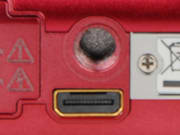
The Kodak EasyShare camera comes with a three-port system similar to other point-and-shoots. Users can recharge their camera via the DC port and view photos on their television via the AV port. The DC port is exposed, leaving the socket vulnerable to the elements, while the AV port is hidden safely under a plastic door on the top corner of the camera’s side. Users can connect the camera using the bottom USB port to view photos or print from a PictBridge-enabled printer.
*Direct Print Options (8.0)
*Kodak V803 users can directly print from the camera through a PictBridge-enabled printer. While there isn’t a dedicated print button, the EasyShare camera carries Kodak’s signature Share button to sort photos and prep them for print or e-mail. Users can tag their favorite pictures and save them to the Favorites folder, accessed through the favorites button.
Once selected, users can print up to 99 copies of a photo. The Share menu is as follows:
The Kodak V803 is compatible with optional dock accessories, including the EasyShare Photo Frame Dock 2 for $39.95 and the
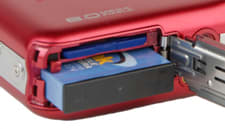
EasyShare 600 Printer Dock for $99.95.
Battery (3.5)
The Kodak EasyShare runs on a rechargeable lithium-ion battery (KLIC-7003). The included 5V AC adapter and power cord charges the battery in approximately two hours. For those with a little extra cash in their pockets, Kodak offers optional dock accessories for charging the camera and connecting to a computer and printer.
*Memory (3.5)
*The V803 has 32MB of internal memory, with 24MB available for actual picture storage.
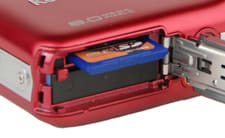
That’s not much in terms of built-in memory, so users will need to buy an additional memory card. The camera accepts SD and MMC media.
Other Features*(3.0)*
Panoramic stitching – Kodak doesn’t talk up its panoramic stitch function much, but it’s still effective (most of the time). While humble, the Panorama mode addition is a nice feature to combine for group pictures and landscape photos. The scene feature takes three frames in succession and automatically stitches them together.
Overall Impressions
Value* (4.0)*
Kodak faces stiff competition, with a number of rivals in the $200 price category. The V803 has basic specs and is attractive, but there are better performing cameras with more advanced features, including face detection technology, available for the same price.
**Comparisons
**[

Canon PowerShot SD40](https://www.reviewed.com/cameras/content/Canon-PowerShot-SD40-Digital-Camera-Review-.htm) – People who are attracted to the short and sweet types might also consider the Canon SD40. At a notably higher introductory price of $349, the Canon camera has a lower 7.1 megapixel count compared to the Kodak V803’s 8-megapixel sensor. The Canon camera also has a smaller 1.8-inch, 118,000-pixel resolution LCD versus the Kodak’s 2.5-inch, 154,000-pixel monitor. The Canon offers a shorter 2.4x optical zoom, less than the Kodak’s 3x optical zoom. What will customers get for that near-$150 price difference? Canon’s face detection technology. Both cameras have a maximum sensitivity of 1600 ISO for shooting in low light. The Canon SD40 offers four color options: Noble Blue, Twilight Sepia, Precious Rose, and Olive Gray, while V803 has eight color options.
[
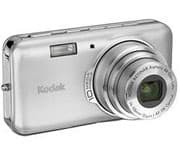
Kodak EasyShare V1003](https://www.reviewed.com/cameras/content/Kodak-Easyshare-V1003-First-Impressions-Review.htm) – Introduced at the same time as the Kodak V803, the Kodak EasyShare V1003 is the slightly more advanced edition of the V803. At about $50 more than the V803, the V1003 offers pretty much the same things as its little sister. The main difference is the V1003 has a higher 10-megapixel count compared to the 8-megapixel V803. Because the variance is so small between these two Kodak cameras, we recommend consumers save the extra $50, unless they are planning on making massive prints with the images captured from the V1003.
[

Fujifilm FinePix Z5](https://www.reviewed.com/cameras/content/Fujifilm-FinePix-Z5fd-First-Impressions-Review.htm)*fd*- The Fuji Z5*fd* offers similar specs to the Kodak V803 at roughly the same price. For about $30 more, at $229, the Fuji camera possesses a 6.3 megapixel count compared to the 8-megapixel EasyShare camera. Both cameras are fitted with a 3x optical zoom lens, although the Fuji’s lens is non-extending. The FinePix and EasyShare cameras both have a high sensitivity at 1600 ISO. Those who opt for the Fuji camera will gain face detection technology and a built-in Web resolution Blog mode. Consumers can also choose from the Z5*fd*’s Wine Red, Chocolate Brown, and Lustrous Brushed Silver colors, while the Kodak V803 is available in eight trendy colors.
[

Sony Cyber-shot DSC-W55](https://www.reviewed.com/cameras/content/Sony-Introduces-DSC-W55-and-W35.htm) – The Sony W55 and Kodak V803 share the same intro price of $200, but have slightly different rap sheets. The 7.2-megapixel Cyber-shot has less resolution than the 8-megapixel EasyShare camera. The Sony W55 is fitted with an equally sized 2.5-inch LCD, but with less monitor resolution at 115,000 pixels compared to the 154,000-pixel resolution of the Kodak V803. Both come equipped with extending 3x optical zoom lenses. The Sony camera has a maximum sensitivity of 1000 ISO, less than the Kodak’s 1600 ISO maximum. Sony offers the W55 in silver, black, pink, and blue.

GE G1 –The GE G1 and the Kodak V803 share the same price tag. The 7-megapixel G1 camera carries fewer megapixels than the 8-megapixel Kodak V803, but the two cameras share comparable monitors and 3x optical zoom lenses. The GE camera possesses a 2.5-inch, 153,600-pixel LCD compared to the 2.5-inch, 154,000-pixel screen on the EasyShare camera. Both have a max 1600 ISO setting and three-image panorama stitch function. Those who purchase the GE G1, however, will gain face detection capabilities and a built-in red-eye removal function.
Who’s this Camera For?
Point and Shooters – Absolutely. The Kodak EasyShare V803 is geared for the type of shooter who simply wants to push the shutter and not think about anything else.
Budget Consumers – At less than $200, the camera falls into the budget category. While consumers can get cameras for even less at online retailers, thrifty shoppers will be attracted to the V803’s low price tag.
Gadget Freaks – Negative. The EasyShare’s basic features likely won’t be enough for this group. Those with a thirst for gadgets will gravitate toward features such as face detection, touch screen abilities, or wireless photo transfer technology.
Manual Control Freaks – Eh. That’s pretty much the reaction a more experienced photographer would have about the EasyShare V803. Since the camera only comes with automatic Scene modes and limited manual controls for settings like aperture and shutter speed, the control freaks will likely look elsewhere. Advanced compact zooms or entry-level DSLRs are better suited to this segment.
Pros / Serious Amateurs – Not at all. Professional photographers are more apt to purchase higher-end cameras, such as pro DSLRs and digital medium format cameras.
Conclusion
Conclusion
The Kodak EasyShare V803 is a cute, fashionable camera. It will likely attract consumers more interested in a camera’s look than its functionality. While there are commendable upgrades with this 8-megapixel edition, including the 1600 ISO maximum and new customizable Maintain Settings mode, the EasyShare V803’s substandard performance and ineffective button design will leave many pretty irritated.
A budget camera isn’t going to give you superior image quality, but you hope it will at least take decent photos. Unfortunately, the V803 hardly achieves even that. While the resolution at the center of your pictures will look crisp, the edges will be blurry. The color accuracy is hamstringed by very poor white balance, meaning many of your photos may come out with an odd color cast, perhaps blue, perhaps yellow, perhaps a startling aqua. Noise levels are very high, especially at high ISO sensitivities, so don’t expect to get clean photos in low light. And finally, the video mode is dismal, creating videos with enough imaging problems to give you a headache just watching them. Kodak will really need to pursue new avenues (besides just pretty colors) to win over customers in the $200 category.
Sample Photos
**Sample Photos
**Click to view the high-resolution image.
Photo Gallery
Specs / Ratings
Specs Table
{{manufacturer_specs_table}}{{raw_scores_table}}
Meet the tester

Karen M. Cheung
Editor
Karen M. Cheung is a valued contributor to the Reviewed.com family of sites.
Checking our work.
Our team is here to help you buy the best stuff and love what you own. Our writers, editors, and experts obsess over the products we cover to make sure you're confident and satisfied. Have a different opinion about something we recommend? Email us and we'll compare notes.
Shoot us an email